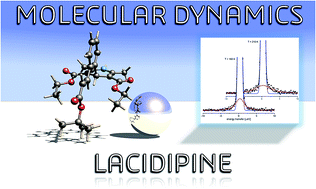On the molecular dynamics in long-acting calcium channel blocker lacidipine: solid-state NMR, neutron scattering and periodic DFT study
Abstract
Molecular and vibrational dynamics of a new-generation lipophilic calcium channel blocker lacidipine (LCDP) are thoroughly explored by combining solid-state nuclear magnetic resonance (NMR) with high-flux quasi-elastic (QENS) and inelastic neutron scattering (INS) experiments. Contrary to the dynamically averaged 13C CP/MAS NMR response, neutron vibrational spectroscopy confirms our previous findings on the thermodynamically stable structure. High-resolution low-wavenumber INS spectrum is reported and fully interpreted based on periodic density functional theory (DFT) calculations in the quasi-harmonic approximation, staying in excellent agreement with the experiment. The INS spectrum was found to be clearly dominated by CH3 torsional features, widely spread over the range of 5–35 meV. 1H NMR relaxation indicates a molecular reorientation with different correlation times. The NMR relaxometry was further combined with an extended QENS study, providing a quantitative description of the intramolecular motions in terms of their activation barriers and correlation times, while their assignment was fully supported by theoretical analysis. While the internal dynamics of side-chain methyl groups can be described by rotation about the threefold-axes, the high-resolution QENS measurements give evidence of rotational tunneling of 2,6-methyl groups at low temperature. The vibrational analysis suggests that strong coupling of methyl librations with lattice modes promotes such an intriguing quantum effect.


 Please wait while we load your content...
Please wait while we load your content...